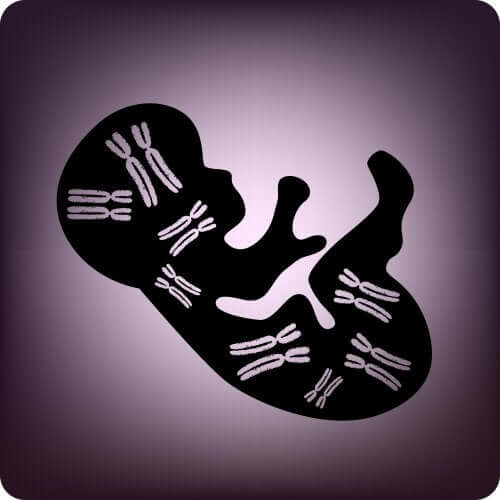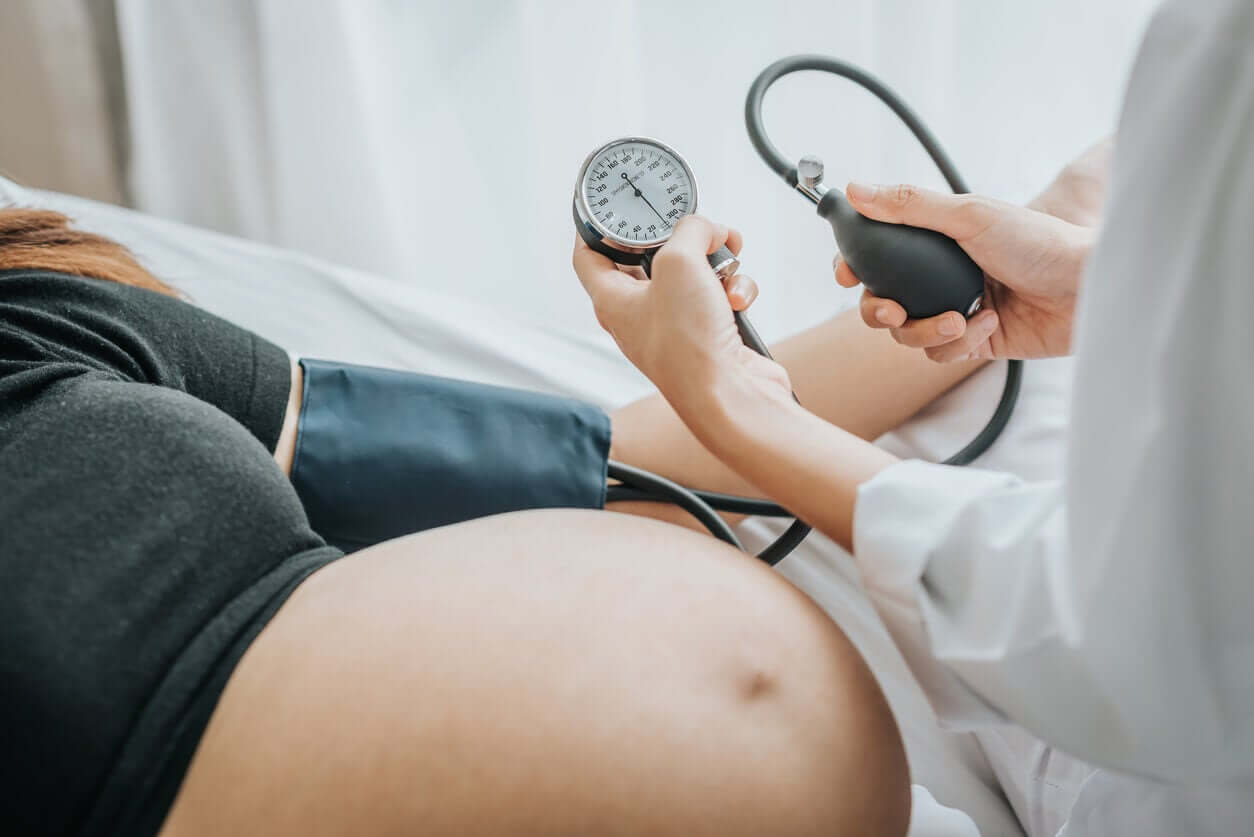What is Triploidy or Triploid Syndrome?


Written and verified by the dermatologist Maria del Carmen Hernandez
Triploidy or triploid syndrome is a poorly diagnosed and little-known condition of the fetus. It includes multiple organ involvement, so its prognosis is unfavorable. In this article, we’ll tell you everything you should know about this rare genetic anomaly.
What’s triploidy or triploid syndrome?
This is a rare chromosomal anomaly in which fetuses are born with an extra set of chromosomes in their cells. A normal set consists of 23 chromosomes, called haploid. Two sets of them, 46 chromosomes, are called diploid. Three sets are called a triploid set.
Typical cells have 46 chromosomes that are grouped in pairs: 23 of them are inherited from the father and 23 from the mother (diploidy). But when all pairs receive an extra chromosome, either from the mother or the father, we speak of triploidy or triploid syndrome.

What causes it?
According to a publication by the National Organization for Rare Diseases, triploidy occurs in 1 to 3% of pregnancies. There are no risk factors, nor is it hereditary. In addition, it’s not more common in older women, like other chromosomal abnormalities.
As mentioned earlier, triploidy is the result of adding an extra chromosome to each normal pair. This happens when two haploid (normal) sperm fertilize the same egg or when a diploid sperm fertilizes a haploid egg. Also, when a haploid sperm fertilizes a diploid egg.
An article published in the journal Clinical Genetics describes two different types of fertilization that can cause triploid syndrome.
- Digenic fertilization: In this variant, the mother’s the one who contributes the additional chromosome. In general, it occurs when she has a diploid egg and is fertilized by a haploid sperm.
- Diandrous fertilization: The father provides the extra chromosome.
Diandrous pregnancies usually result in early miscarriages, unlike digenic pregnancies, which tend to be lost by the end of the third trimester.
A hydatidiform mole, which is a type of tumor composed of trophoblastic cells and characterized by its slow growth, can cause triploidy. It can even lead to multiple complications, such as an increased risk of another molar pregnancy or cancer.
Differences between triploidy and trisomy
Trisomy is a genetic condition similar to triploidy, which occurs when specific pairs of chromosomes receive an extra chromosome from a parent. The most common are the following:
- Patau syndrome (Trisomy 13)
- Trisomy 18 (Edwards syndrome)
- Down syndrome (Trisomy 21)
The extra chromosome can also cause impairments in mental and physical development. However, a higher percentage of children born with trisomy live to adulthood with full-time, long-term care.
Symptoms of triploidy
The few babies who survive until birth have multiple defects. Some of the most common are the following:
- Heart defects
- Intrauterine growth retardation
- Neural tube defects, such as spina bifida
- Kidney defects, such as polycystic kidney
- Limb abnormalities, such as webbing of the fingers and toes
Babies born with triploidy usually don’t live for more than a couple of days. However, those born with mosaic triploidy (in which the number of chromosomes isn’t the same in all cells) survive more years after birth.
Pregnant women with triploid fetuses may develop preeclampsia, a condition that can manifest with the following symptoms:
- Hypertension
- Edema
- Elevated levels of albumin protein in the urine (albuminuria)
An article published by the journal Human Pathology suggests that it’s important to know the breadth of the spectrum of triploid syndrome, which ranges from near normal to multiple organ involvement.
Is it easy to diagnose?
Chromosome analysis, called “karyotyping,” is the only test that confirms the diagnosis of triploidy. This test quantifies the chromosomes in the fetus’ genes to determine the existence of extra chromosomes.
Amniocentesis, which is another test for genetic disorders, can also be very useful. Triploid syndrome can even be suspected and diagnosed during ultrasounds, as the physician can look for abnormalities.
Are there therapeutic options for triploid babies?
Triploid syndrome is a lethal condition. In fact, fetuses with this type of abnormality rarely survive to be born. The vast majority result in miscarriages during the first trimester of pregnancy, while others are stillborn before reaching term.
If the physician suspects the disease during pregnancy, the mother can decide to terminate the pregnancy, go to term, or wait for a miscarriage. If the mother chooses to continue the pregnancy to term, she should be monitored to avoid complications such as the following:
- Preeclampsia, which can be life-threatening.
- Choriocarcinoma, a rare type of cancer caused by tissue from a partial molar pregnancy.

The prognosis of triploidy or triploid syndrome
A pregnancy with triploid syndrome doesn’t increase the chances of another pregnancy with the same conditions. Therefore, you should feel confident to conceive again, without worrying that there’s an increased risk. Also, you should always maintain prenatal testing and care to ensure that your baby receives the best possible care.
Triploidy or triploid syndrome is a poorly diagnosed and little-known condition of the fetus. It includes multiple organ involvement, so its prognosis is unfavorable. In this article, we’ll tell you everything you should know about this rare genetic anomaly.
What’s triploidy or triploid syndrome?
This is a rare chromosomal anomaly in which fetuses are born with an extra set of chromosomes in their cells. A normal set consists of 23 chromosomes, called haploid. Two sets of them, 46 chromosomes, are called diploid. Three sets are called a triploid set.
Typical cells have 46 chromosomes that are grouped in pairs: 23 of them are inherited from the father and 23 from the mother (diploidy). But when all pairs receive an extra chromosome, either from the mother or the father, we speak of triploidy or triploid syndrome.

What causes it?
According to a publication by the National Organization for Rare Diseases, triploidy occurs in 1 to 3% of pregnancies. There are no risk factors, nor is it hereditary. In addition, it’s not more common in older women, like other chromosomal abnormalities.
As mentioned earlier, triploidy is the result of adding an extra chromosome to each normal pair. This happens when two haploid (normal) sperm fertilize the same egg or when a diploid sperm fertilizes a haploid egg. Also, when a haploid sperm fertilizes a diploid egg.
An article published in the journal Clinical Genetics describes two different types of fertilization that can cause triploid syndrome.
- Digenic fertilization: In this variant, the mother’s the one who contributes the additional chromosome. In general, it occurs when she has a diploid egg and is fertilized by a haploid sperm.
- Diandrous fertilization: The father provides the extra chromosome.
Diandrous pregnancies usually result in early miscarriages, unlike digenic pregnancies, which tend to be lost by the end of the third trimester.
A hydatidiform mole, which is a type of tumor composed of trophoblastic cells and characterized by its slow growth, can cause triploidy. It can even lead to multiple complications, such as an increased risk of another molar pregnancy or cancer.
Differences between triploidy and trisomy
Trisomy is a genetic condition similar to triploidy, which occurs when specific pairs of chromosomes receive an extra chromosome from a parent. The most common are the following:
- Patau syndrome (Trisomy 13)
- Trisomy 18 (Edwards syndrome)
- Down syndrome (Trisomy 21)
The extra chromosome can also cause impairments in mental and physical development. However, a higher percentage of children born with trisomy live to adulthood with full-time, long-term care.
Symptoms of triploidy
The few babies who survive until birth have multiple defects. Some of the most common are the following:
- Heart defects
- Intrauterine growth retardation
- Neural tube defects, such as spina bifida
- Kidney defects, such as polycystic kidney
- Limb abnormalities, such as webbing of the fingers and toes
Babies born with triploidy usually don’t live for more than a couple of days. However, those born with mosaic triploidy (in which the number of chromosomes isn’t the same in all cells) survive more years after birth.
Pregnant women with triploid fetuses may develop preeclampsia, a condition that can manifest with the following symptoms:
- Hypertension
- Edema
- Elevated levels of albumin protein in the urine (albuminuria)
An article published by the journal Human Pathology suggests that it’s important to know the breadth of the spectrum of triploid syndrome, which ranges from near normal to multiple organ involvement.
Is it easy to diagnose?
Chromosome analysis, called “karyotyping,” is the only test that confirms the diagnosis of triploidy. This test quantifies the chromosomes in the fetus’ genes to determine the existence of extra chromosomes.
Amniocentesis, which is another test for genetic disorders, can also be very useful. Triploid syndrome can even be suspected and diagnosed during ultrasounds, as the physician can look for abnormalities.
Are there therapeutic options for triploid babies?
Triploid syndrome is a lethal condition. In fact, fetuses with this type of abnormality rarely survive to be born. The vast majority result in miscarriages during the first trimester of pregnancy, while others are stillborn before reaching term.
If the physician suspects the disease during pregnancy, the mother can decide to terminate the pregnancy, go to term, or wait for a miscarriage. If the mother chooses to continue the pregnancy to term, she should be monitored to avoid complications such as the following:
- Preeclampsia, which can be life-threatening.
- Choriocarcinoma, a rare type of cancer caused by tissue from a partial molar pregnancy.

The prognosis of triploidy or triploid syndrome
A pregnancy with triploid syndrome doesn’t increase the chances of another pregnancy with the same conditions. Therefore, you should feel confident to conceive again, without worrying that there’s an increased risk. Also, you should always maintain prenatal testing and care to ensure that your baby receives the best possible care.
All cited sources were thoroughly reviewed by our team to ensure their quality, reliability, currency, and validity. The bibliography of this article was considered reliable and of academic or scientific accuracy.
- Aspectos Genéticos de la Mola hidatidiforme. Perinatología y Reproducción Humana. (2015, December 23). https://www.sciencedirect.com/science/article/pii/S0187533715000369
- Doshi, N., Surti, U., & Szulman, A. E. (1983). Morphologic anomalies in triploid liveborn fetuses. Human pathology, 14(8), 716–723. https://pubmed.ncbi.nlm.nih.gov/6683705/
- Massalska, D., Bijok, J., Kucińska-Chahwan, A., Zimowski, J. G., Ozdarska, K., Panek, G., & Roszkowski, T. (2021). Triploid pregnancy-Clinical implications. Clinical genetics, 100(4), 368–375. https://pubmed.ncbi.nlm.nih.gov/34031868/
- Triploidy – symptoms, causes, treatment: Nord. National Organization for Rare Disorders. (2023b, January 12). https://rarediseases.org/rare-diseases/triploidy/
This text is provided for informational purposes only and does not replace consultation with a professional. If in doubt, consult your specialist.








